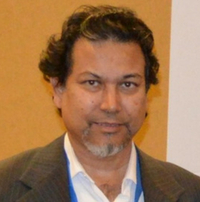
Anis Rahman* and Aunik Rahman
President/CTO, Applied Research & Photonics, Inc., USA
Title: Screening a cancerous cell with terahertz multispectral imaging
Biography
Biography: Anis Rahman* and Aunik Rahman
Abstract
Recently terahertz multispectral reconstructive imaging has attracted tremendous attention for soft tissue imaging because of the non-ionizing nature of the T-ray that does not impart any radiation damage like X-ray. Here, examples of human skin tissue imaging are presented. Reconstructive imaging utilizes the technique of rasterizing a specimen over a given volume. The resulting three-dimensional matrix, termed as the Beer-Lambert reflection (BLR) matrix, is utilized to compute a 3D lattice for the image generation. ARP’s instrument allows the T-ray beam to be focused on a given layer under the surface; therefore, a 3D volume may be rasterized on a layer by layer basis. The algorithm used for image generation is capable of accurate representation of the measured object similar to a charged couple device as has been explained elsewhere. Here we present images of human skin under different diseased conditions as compared to healthy skin samples. Fig. 1 exhibits terahertz reconstructive 3D image of a skin sample where regular cellular pattern is visible. However, some cell has started deforming because of the onset of disease attack. As outlined, a combination of presence or absence of regular cellular structure, terahertz spectral comparison, and lack or presence or layering information is expected to serve as a fool proof diagnostic tool for different kind of skin cancers.

